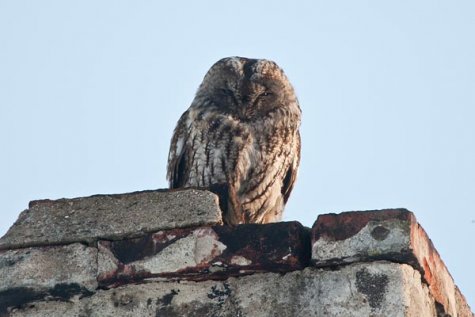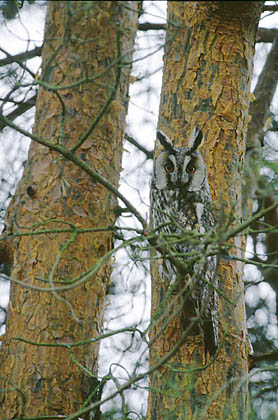Have you heard a tawny owl this year?
Photos: Arne Ader
Translation: Liis
Tawny owl
Tawny owl Kodukakk Strix aluco
The tawny owl is without doubt our most familiar ”owl”. The bird has its name because it nests near people’s homes.
It is an owl that is extremely true to its nest site. Tawny owls have inhabited some parks or cemeteries with ancient trees for decades.
In the morning or evening twilight we can see the bird – that melts well into nature – sitting in trees or posts at roadsides. The flight is gently sloping when they check their hunting territories – forest verges, fields, meadows as well as the yards of summer houses and farmhouses. Observing tawny owls is not an easy task, the owl discovers the observers rather than the other way about. Daytime is slept off, in the attics of residential houses or other buildings that can be entered. Such an image of a tawny owl sitting at the top of a chimney is no rarity. The tawny owl pair hoo-hoos to each other in the web camera nesting park already at about 7 o’clock in the evening, and probably elsewhere as well. You can hear the nesting-time conversations between themselves yourself; it is more complicated to describe.
The eyes of the tawny owl are dark and they are surrounded by noticeable feather circles; the beak is pale yellow. The stocky body leaves an impression of a strong bird. The length of the tawny owl is less than 40 centimetres and the females are just a whit longer and somewhat heavier by weight than the males – about half a kilo. The span of the broad wings stays below a metre.
Two different plumage colours exist among tawny owls: rust brown or ash grey, why this is so, not even researchers know precisely.
Among owls inhabiting cultured landscapes we can also meet the long-eared owl (who is revealed by its long ear tufts) but the tawny owl is slightly larger and generally with darker plumage..
Long-eared owl
Long-eared owl Kõrvukräts Asio otus










